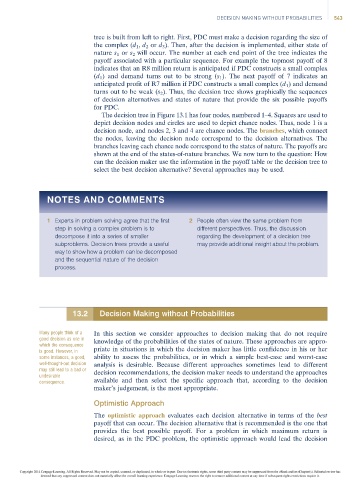Page 563 -
P. 563
DECISION MAKING WITHOUT PROBABILITIES 543
tree is built from left to right. First, PDC must make a decision regarding the size of
the complex (d 1 , d 2 or d 3 ). Then, after the decision is implemented, either state of
nature s 1 or s 2 will occur. The number at each end point of the tree indicates the
payoff associated with a particular sequence. For example the topmost payoff of 8
indicates that an R8 million return is anticipated if PDC constructs a small complex
(d 1 ) and demand turns out to be strong (s 1 ). The next payoff of 7 indicates an
anticipated profit of R7 million if PDC constructs a small complex (d 1 ) and demand
turns out to be weak (s 2 ). Thus, the decision tree shows graphically the sequences
of decision alternatives and states of nature that provide the six possible payoffs
for PDC.
The decision tree in Figure 13.1 has four nodes, numbered 1–4. Squares are used to
depict decision nodes and circles are used to depict chance nodes. Thus, node 1 is a
decision node, and nodes 2, 3 and 4 are chance nodes. The branches, which connect
the nodes, leaving the decision node correspond to the decision alternatives. The
branches leaving each chance node correspond to the states of nature. The payoffs are
shown at the end of the states-of-nature branches. We now turn to the question: How
can the decision maker use the information in the payoff table or the decision tree to
select the best decision alternative? Several approaches may be used.
NOTES AND COMMENTS
1 Experts in problem solving agree that the first 2 People often view the same problem from
step in solving a complex problem is to different perspectives. Thus, the discussion
decompose it into a series of smaller regarding the development of a decision tree
subproblems. Decision trees provide a useful may provide additional insight about the problem.
way to show how a problem can be decomposed
and the sequential nature of the decision
process.
13.2 Decision Making without Probabilities
Many people think of a In this section we consider approaches to decision making that do not require
good decision as one in knowledge of the probabilities of the states of nature. These approaches are appro-
which the consequence
is good. However, in priate in situations in which the decision maker has little confidence in his or her
some instances, a good, ability to assess the probabilities, or in which a simple best-case and worst-case
well-thought-out decision analysis is desirable. Because different approaches sometimes lead to different
may still lead to a bad or
undesirable decision recommendations, the decision maker needs to understand the approaches
consequence. available and then select the specific approach that, according to the decision
maker’s judgement, is the most appropriate.
Optimistic Approach
The optimistic approach evaluates each decision alternative in terms of the best
payoff that can occur. The decision alternative that is recommended is the one that
provides the best possible payoff. For a problem in which maximum return is
desired, as in the PDC problem, the optimistic approach would lead the decision
Copyright 2014 Cengage Learning. All Rights Reserved. May not be copied, scanned, or duplicated, in whole or in part. Due to electronic rights, some third party content may be suppressed from the eBook and/or eChapter(s). Editorial review has
deemed that any suppressed content does not materially affect the overall learning experience. Cengage Learning reserves the right to remove additional content at any time if subsequent rights restrictions require it.

